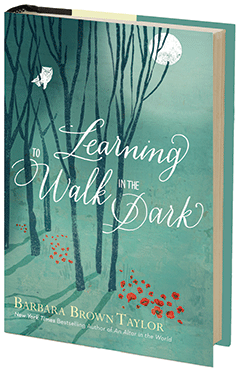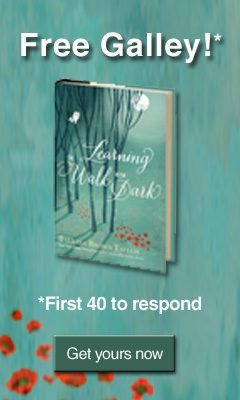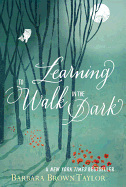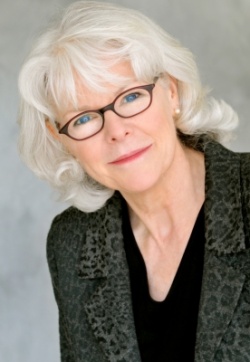Learning to Walk in the Dark
by Barbara Brown Taylor
Conventional wisdom has it that light is associated with good, while darkness represents evil and danger. Barbara Brown Taylor believes otherwise. In Learning to Walk in the Dark, she compellingly makes the case for why darkness is as necessary to our well-being as light, and that to have one without the other is to live only half a life.
The dangerousness of the dark is "like the law of gravity. No one could say exactly how it worked, but everyone agreed on it," writes Taylor. Distrust of the dark often begins in childhood, with kids called indoors at dusk to keep them safe, and is reinforced as we grow older. When Taylor told people she was writing a book about darkness, reactions were uniformly negative, with darkness equated to spiritual warfare, depression, nightmares and other adverse notions.
More determined than dissuaded by the reaction, Taylor continued exploring physical, emotional and spiritual darkness. She invites readers along on her journey, illuminating through her experiences a topic that is both universal and deeply personal. A charming, witty and wise guide into the heart of darkness, she reveals the beauty and riches to be found there and shares the life-shaping lessons she would never have learned in the light.
Vowing to follow darkness no matter where it leads her, Taylor travels from the pages of the Bible into the belly of a "wild" cave in West Virginia to Chartres Cathedral in France. Woven into the narrative are elements of cosmology, biology, psychology, history and theology, offering a thought-provoking and often surprising study of a topic most people actively try to avoid.
With chapters following the phases of the moon, Taylor launches her quest in her own backyard in the Georgia countryside, where she moved years ago for a better view of the night sky. On the eve of a full moon, she begins her study of darkness "with the real thing, paying attention to it the way an artist or an astronomer might, instead of using it to gauge how much more I can get done before bed." Literal darkness is often a trigger or metaphor for other kinds, such as emotional and spiritual darkness, territory she mines next.
An ordained Episcopal minister and former parish priest, Brown left the church after a crisis of faith, due in part to her reluctance to buy into the "solar spirituality" advocated by Christianity--the idea that one must walk in the light to be close to God and steadfastly avoid darkness. Since earliest times in the religion, darkness has been used as a synonym for sin, ignorance, spiritual blindness and death.
Instead, Taylor's faith has room for lunar spirituality as well. After all, she reasons, "Even when light fades and darkness falls--as it does every single day, in every single life--God does not turn the world over to some other deity." The moon, waxing and waning with the seasons, is a truer mirror for her soul than the sun, which looks the same every day. Taylor turns to the Bible to help prove her point, highlighting a collection of positive stories in the scriptures that happen after dark.
Regardless of where readers stand on the spiritual spectrum, there is plenty to ponder. Darkness affects each of us individually, but as Taylor shows there are also larger ramifications--social, cultural, economic and environmental--to our propensity to shun darkness. For example, the brightest spots on earth are the ones where the most prosperous people live, marshalling money and power to eradicate the dark. Due to light pollution, the Milky Way is now invisible to two-thirds of those living in the United States.
How does it feel to have dark skin or to be blind in a society that equates darkness with evil? In one of the most compelling sections in the book, Taylor recalls participating in the exhibit "Dialogue in the Dark," which simulated an environment that allowed sighted people to experience what it's like to be blind.
Taylor has filled Learning to Walk in the Dark with fascinating facts and anecdotes, from the origin of the word "night," which comes from Greek myth, to insights on insomniacs like Mark Twain and Van Gogh, who often did their best work during the darkest hours, to why she learned as much about human nature waitressing at an underground bar as she did writing papers for seminary classes.
Ultimately, Taylor challenges us to think differently about a subject we've largely been led to believe is unassailable. She encourages readers to become more curious about their own darkness, to shed preconceived ideas and find out for themselves what is true. After finishing the book, switch off the lights. It's a safe bet you won't see darkness the same way after spending time with Taylor, whose grace and wisdom light the way toward embracing "endarkenment."
Taylor admits that she has never written a book she was sadder to wrap up than this one, having enjoyed the writing of it so immensely. Her consolation is knowing that when night falls she can step out on her porch and "see the moon... shining down on me like another mother, saying, 'Come outside now, it's getting dark.' " --Shannon McKenna Schmidt








